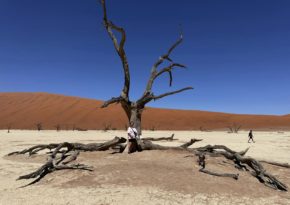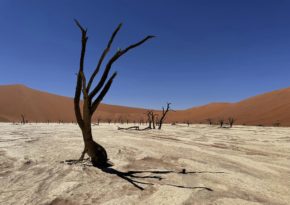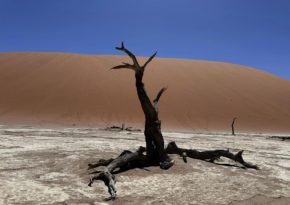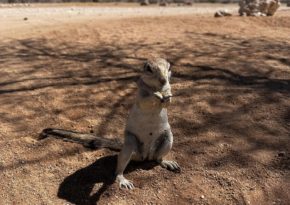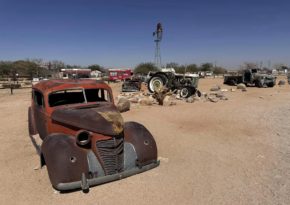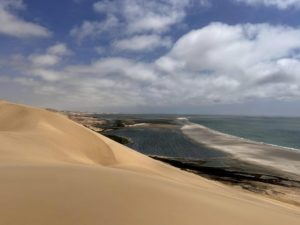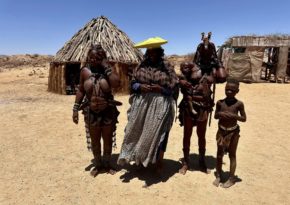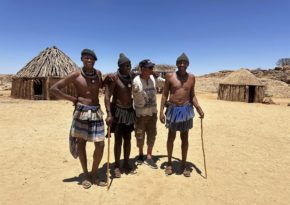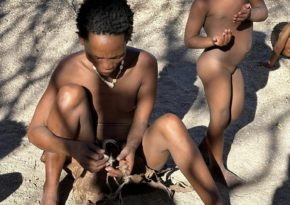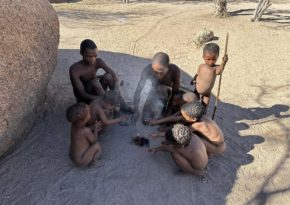Across Namibia by pickup truck. Part 2.
There is a place in the Namib desert with a terrifying name Deadvlei (Dead Valley).
Being situated among the sands and surrounded by high orange dunes, this place fascinates with its minimalism and bright colors. There are black trees on the white surface of a dried-up lake, which have bright orange dunes and the blue sky on the background.
It makes just an amazing impression!
Hundreds of years ago the Tsauhab river used to flow across the Namib desert, forming lakes in which life was in full swing and tall trees with dense green crowns grew.
But time had passed and the desert blocked the riverbed, so all the lakes dried up. The trees died and turned into bizarrely curved twisted snags.
The heat and wind completed their dirty business and the once beautiful river and lakes became a lifeless valley of death.
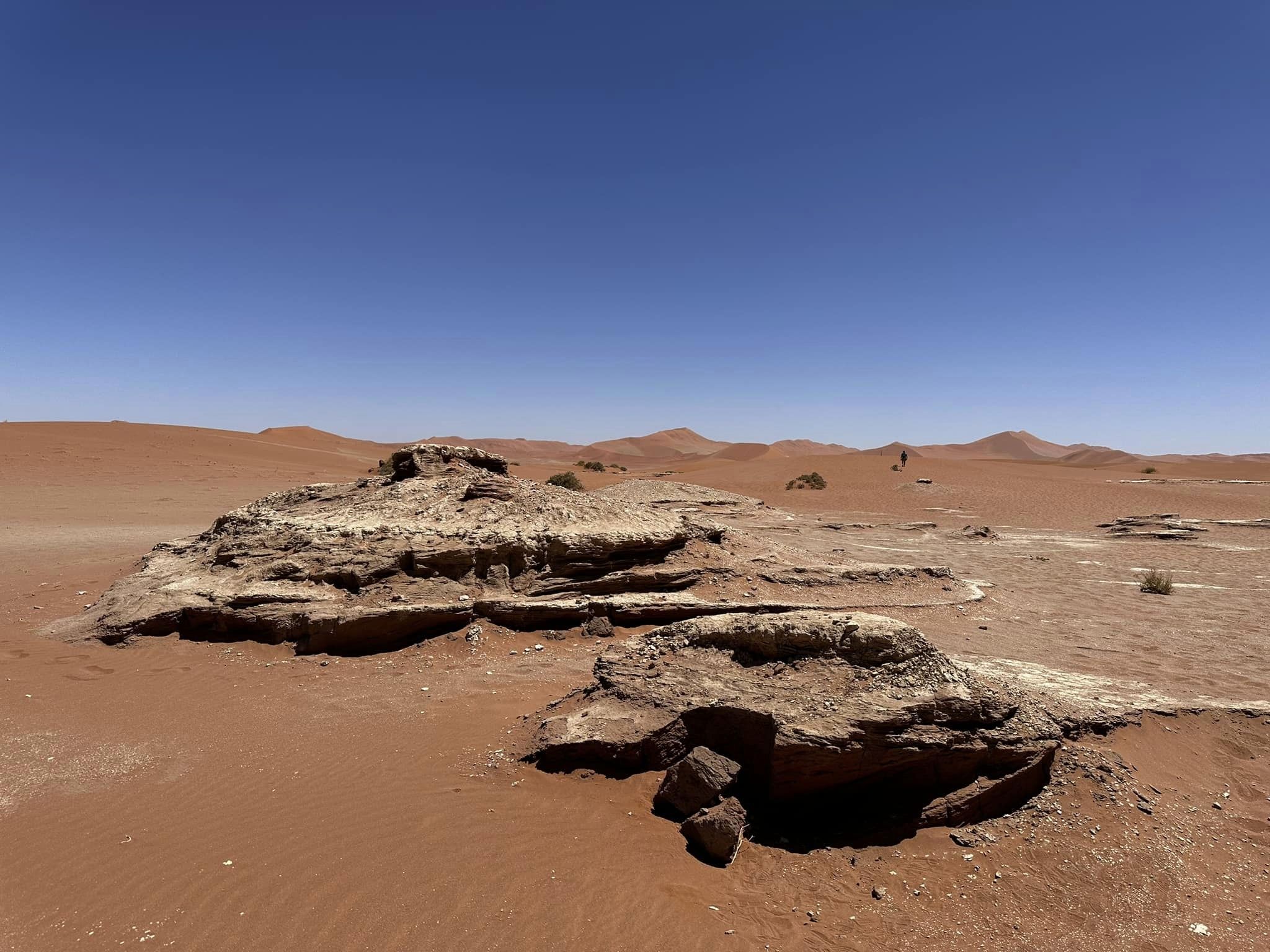
There are a lot of picturesque and unusual places in Namibia. Most of them are connected with natural source, but you can find not only such..
There is a petrol station at the entrance to the small town called Solitare. (-23.893743, 16.005427))
However, it is not an ordinary petrol station, but a museum, a zoo, a campsite, a coffee shop with delicious pies being baked right there, as well as a place of pilgrimage of many tourists and travellers.
Right in front of the petrol station there is a tree, under which a family of chipmunks live in their burrow. They are so used to people that they will eat a piece of pie right out of your hands, if you offer them one.
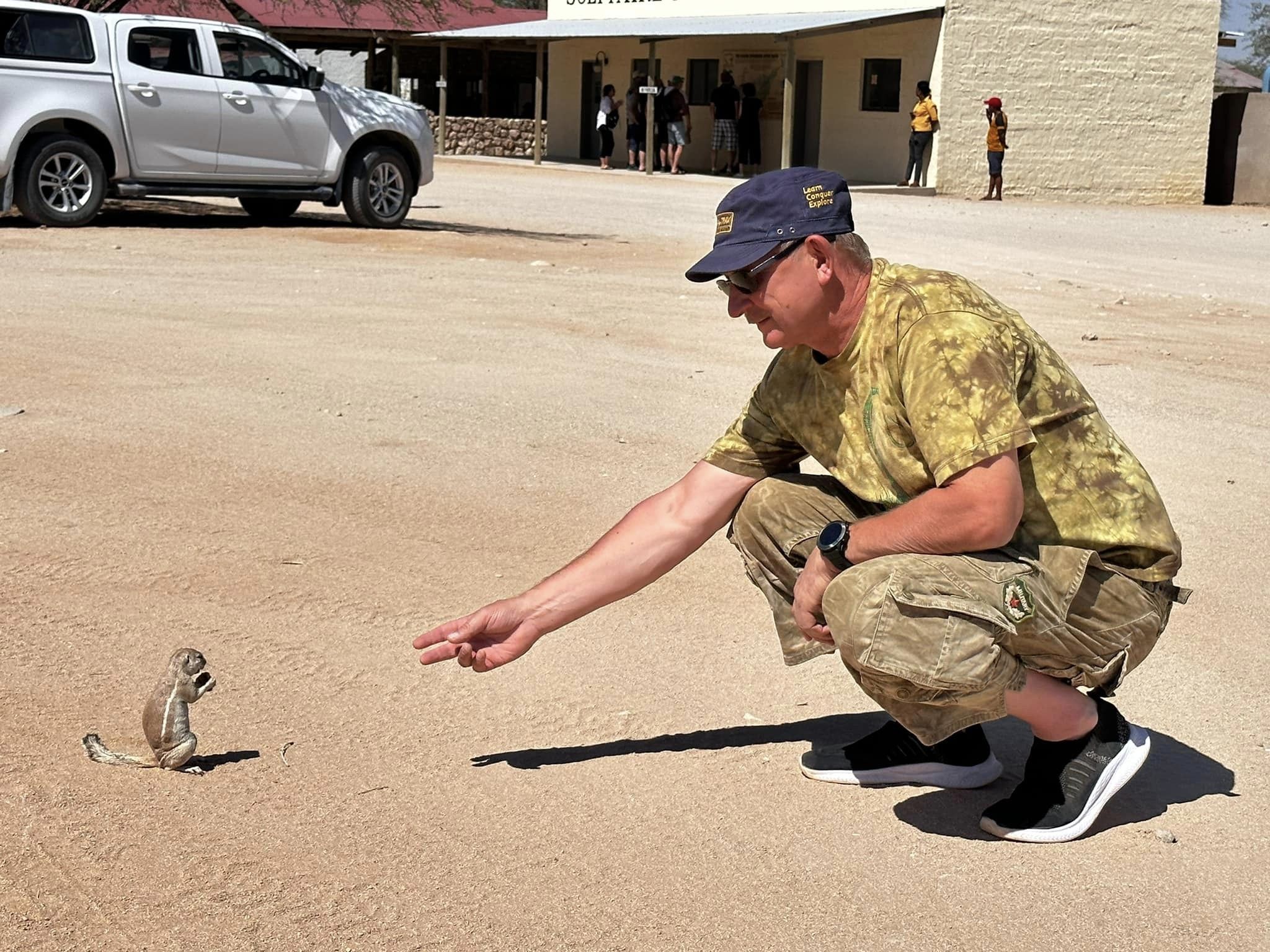
Chipmunks are very funny when they run around the territory, squeezing between cars and speakers.
At the same place you can spot some remains of the aged cars and many other interesting things from the middle of the last century, which are scattered in a chaotic manner all around.
And I have never seen so many stickers of travellers anywhere else in the world! They are on windows, doors and walls of the buildings.
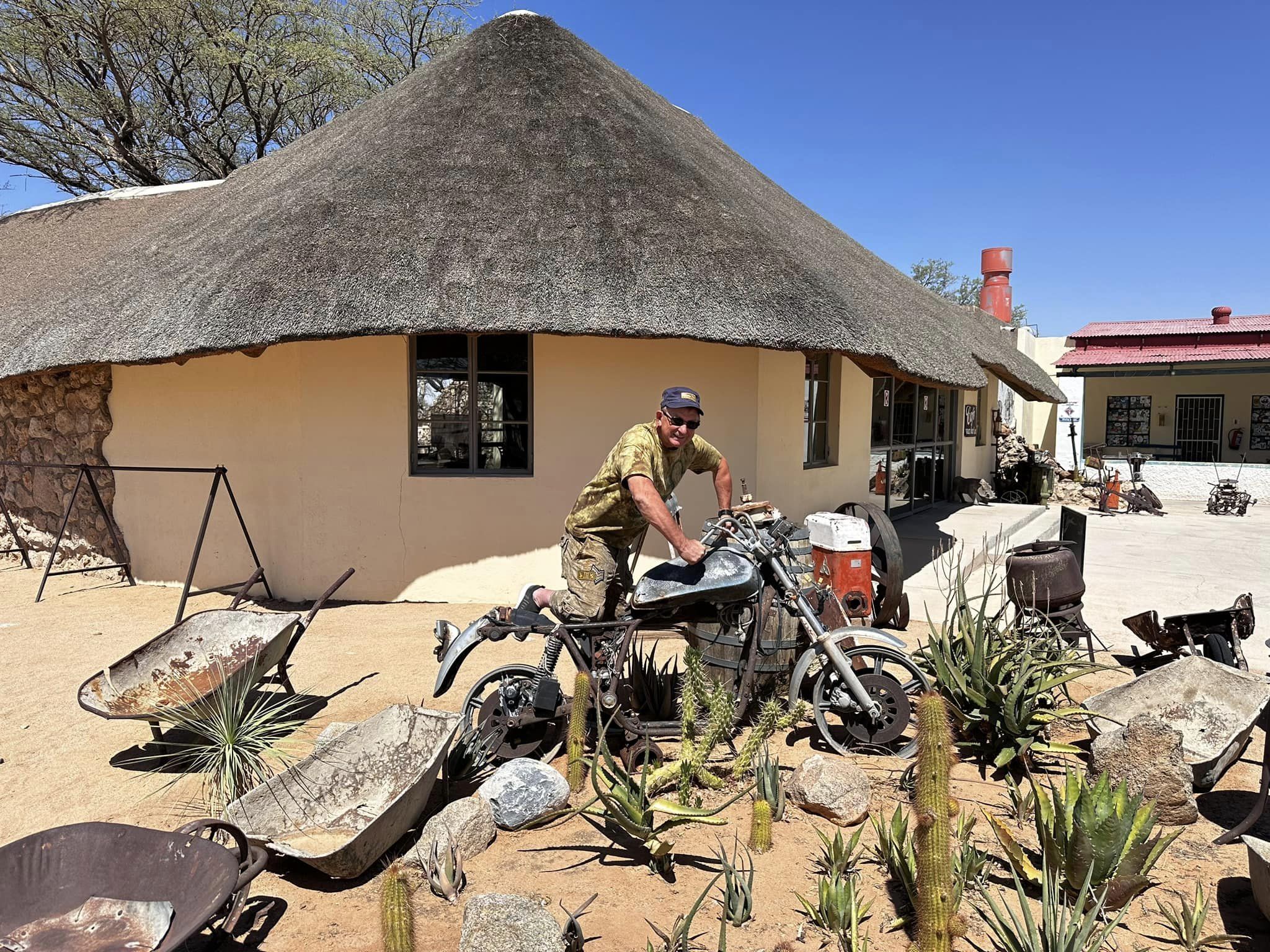
After my journey there appeared one more. :)

One can write a short story about each day of my spontaneous car trip to Namibia!!
Now we have been here for a week and covered only 3000 kilometers, but it seems that I am travelling around Africa for more than one month.
And today was just a fantastic day! In the morning we had a catamaran trip across the ocean to the peninsula, where a huge colony of fur seals lived. There were thousands of them! And at the very beginning, as soon as we left the pier, two pelicans glided onto the boat like two heavy bombers.
They were strolling around the deck, snapping their half-meter beaks, pestering the people and begging for fish. Then a fur seal jumped onto the deck right out of the water and began to walk up and down like a dog, poking his nose at our feet and looking prayerfully into everyone's eyes too.
And some dolphins were playing in the water around the catamaran. There were many of them of different size. They were either swimming forward, jumping out of the water in front of the bow of the boat, or going in the fairway, frolicking with each other. It is clear that they were also waiting for some award for their performance.
Only the flamingos did not pay any attention to us and were swaggering along the shallows on their thin-as-bamboo-sticks legs bent in the opposite direction. They were lowering their heads with a huge hook-shaped beak into the water, looking for something there.
Let alone the gulls and cormorants circling above us all the time... It was just some kind of immersion into the world of animals and birds!

And after lunch we had a planned three-hour trip across the sand dunes of the Namib desert by off-road vehicles. It was a kind of a merry-go-round, but I'll tell you about it later...
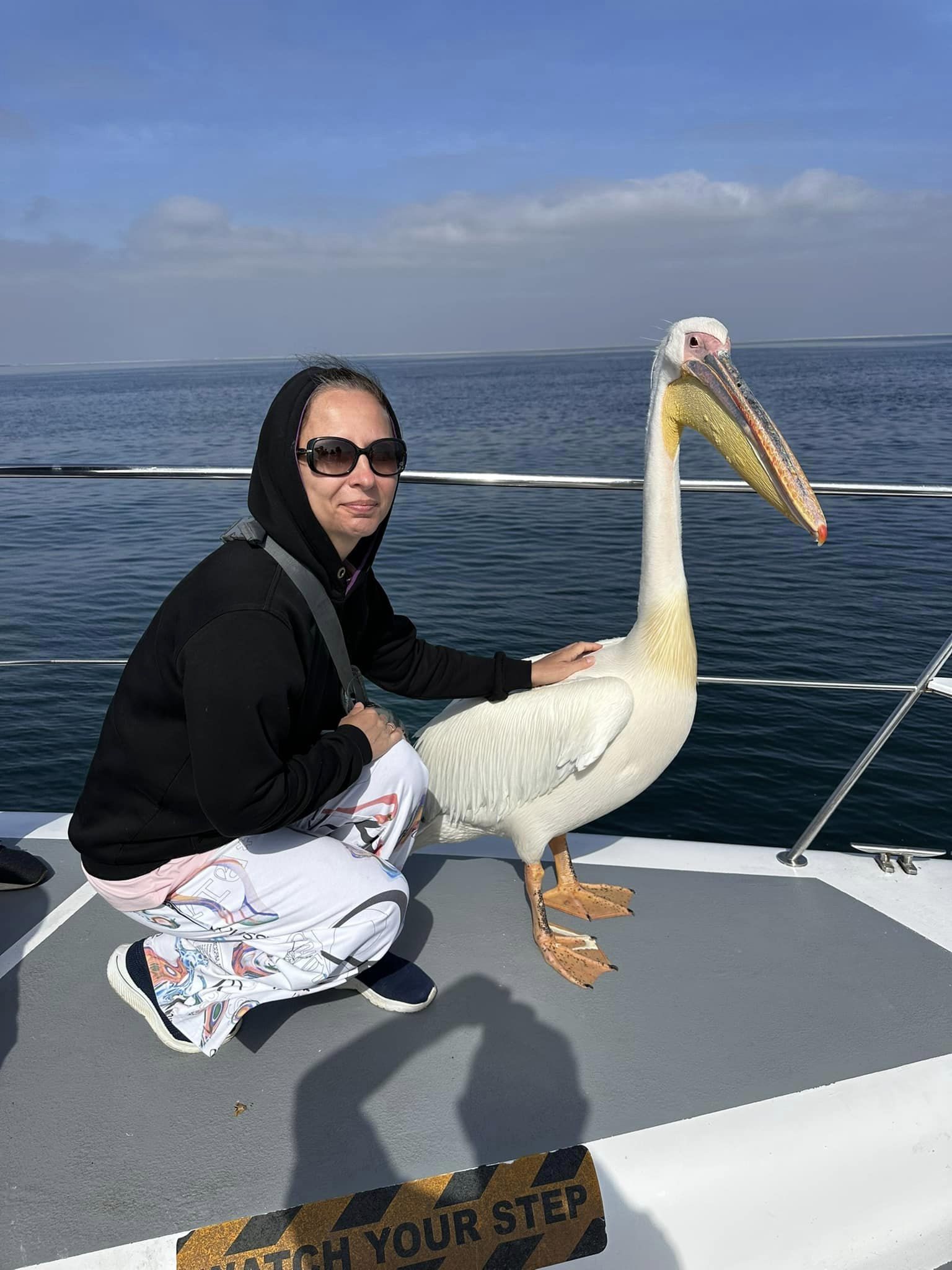
To go on a jeep safari across the Namib desert is a very exciting amusement!
Hardly will you be able to drive on your own across the huge dunes that go beyond the horizon.
Firstly, your car may not be the right one. I have already driven three thousand kilometers by my SUZUKI pickup truck with an automatic transmission and realized that it is not suitable for such extreme trips. The locals go by three-liter diesel Toyota Prado with a manual transmission to make it work.
Secondly, you need to know the track or have accurate navigation. It won't be that hard to slide down from a high dune (together with a layer of creaking sand). But to climb to the top...
Thirdly, it is absolutely impossible to go alone. In case you got stuck or turned over, it would be very difficult to go on foot along the loose, hot sand at a temperature of +40°C, even knowing the right direction. This is the same rule as when going to the mountains by snowmobiles. The risk is quite serious.
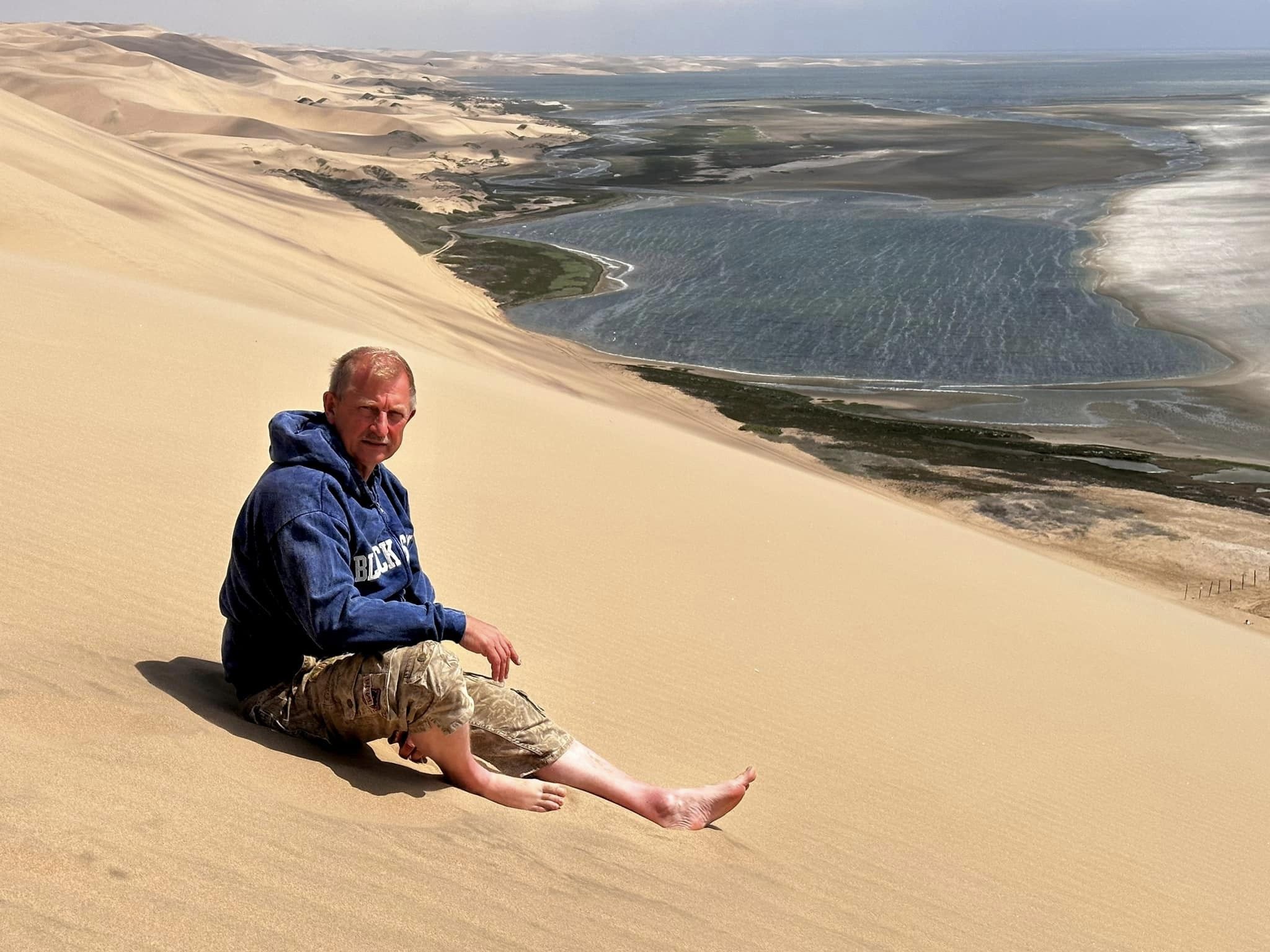
We took two cars and first went to the Atlantic, then followed a narrow sandy strip between the dunes and the ocean – a meeting point of hot sands and boundless water.
We drove fast, keeping off dozens of corpses of fur seals with seagulls sitting on them. I haven't understood the reason for their crawling ashore and dying.
Then we went deep into the desert, climbing to the gentle slopes of the dunes with an acceleration. By such a tricky route we managed to climb one of the peaks offering a stunning view of the ocean and the desert. The wind was very strong, so some fine sand littered our eyes, ears, hair and everything else.
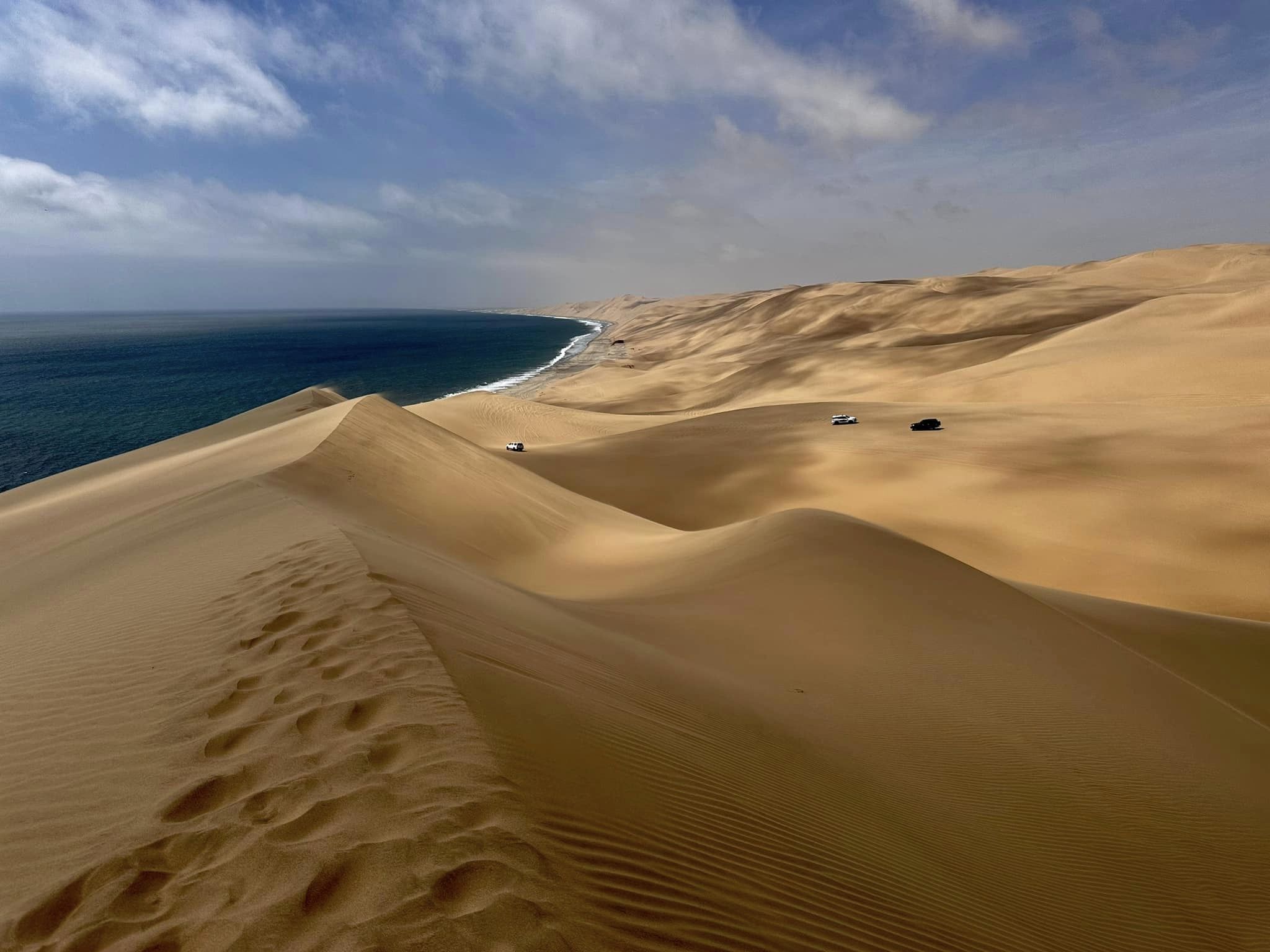
One moment the driver stopped, got out of the car and began to dig sand out with his hands. After a minute of making a hole, he pulled a funny small lizard (gecko) out of it. That was such an amusing show!
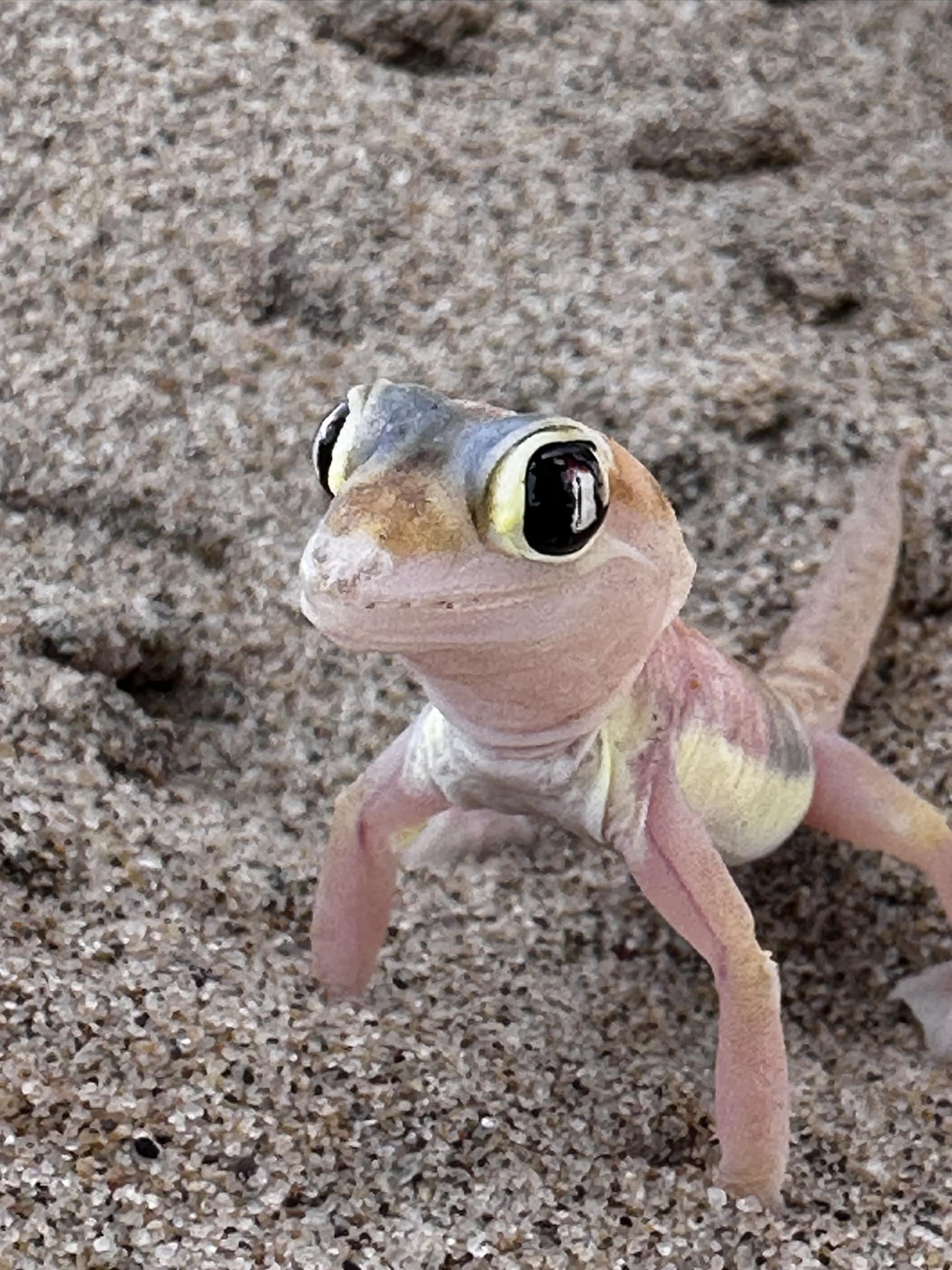
Namibia is a home to dozens of folks, many of whom were almost exterminated by colonists in the early 20th century.
Yesterday we were visiting Himba, which is a tribe of nomads living in the north of the country.
One of the Himba settlements is located near the Spitzkoppe National reserve. (-21.848829, 15.204355)
Having found a guide and an interpreter, we went to the village. Approaching the first house, we stopped and a few minutes later the headman and two men came out to meet us. All three were tall, black and stout, especially the young guy. They were wearing loincloths or short skirts in front, leather aprons in the back, sandals on their feet and some knitted hats on their heads.
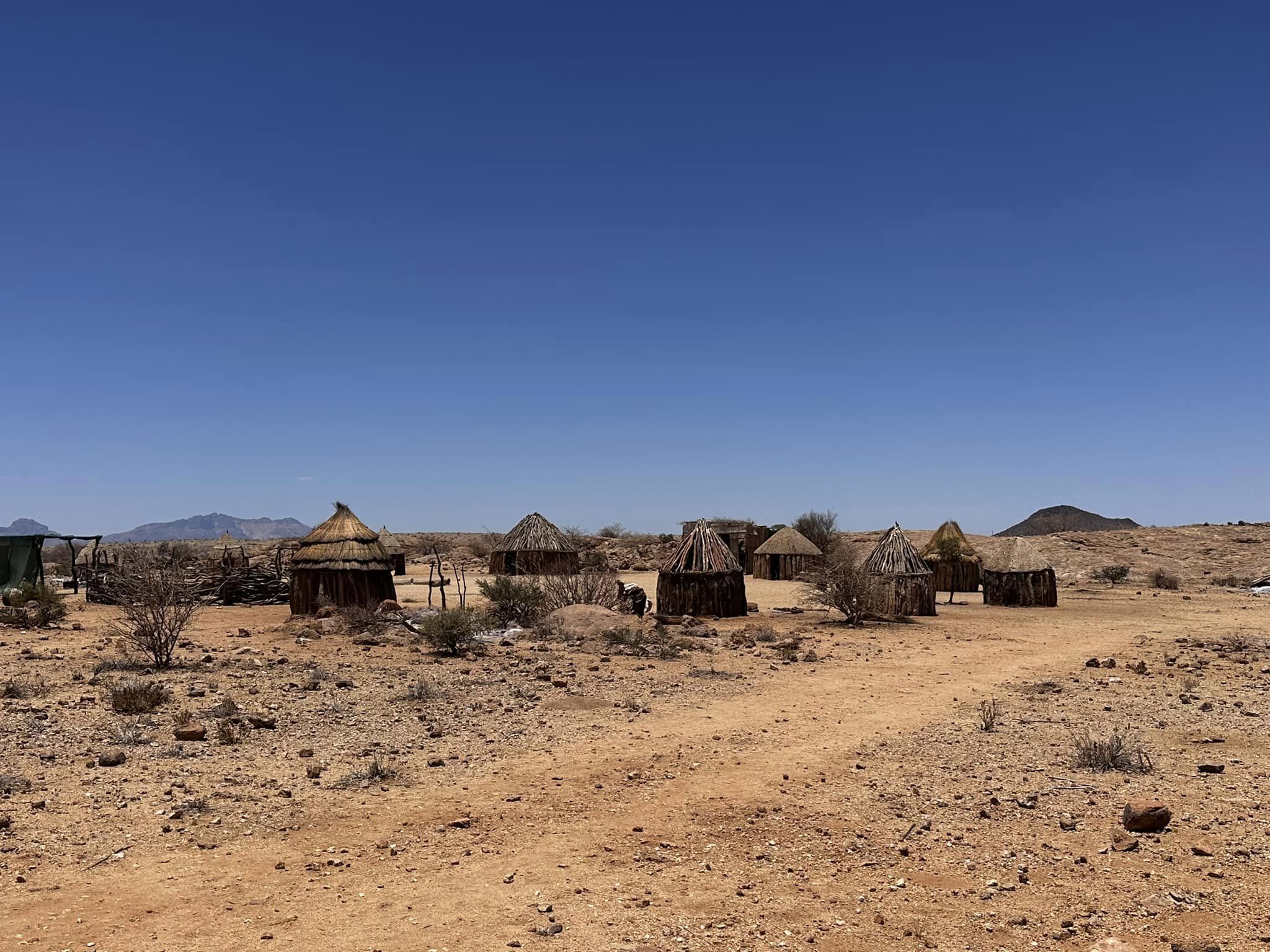
Well, in addition, they had a knife on their belts and pieces of jewelry on their necks.
That produced such an authentic vibe!
We had a talk with the men and then the headman called for the women and children.
- Женщины племени Химба. Намибия.
Well, womem certainly looked even brighter! They were wearing a huge amount of jewelry on their heads, bodies and legs. They also had fancy headdresses and dreadlocks that were covered with some kind of mixture resembling red clay (as well as the whole body).
Leather skirts and sandals were, in general, all their clothes.
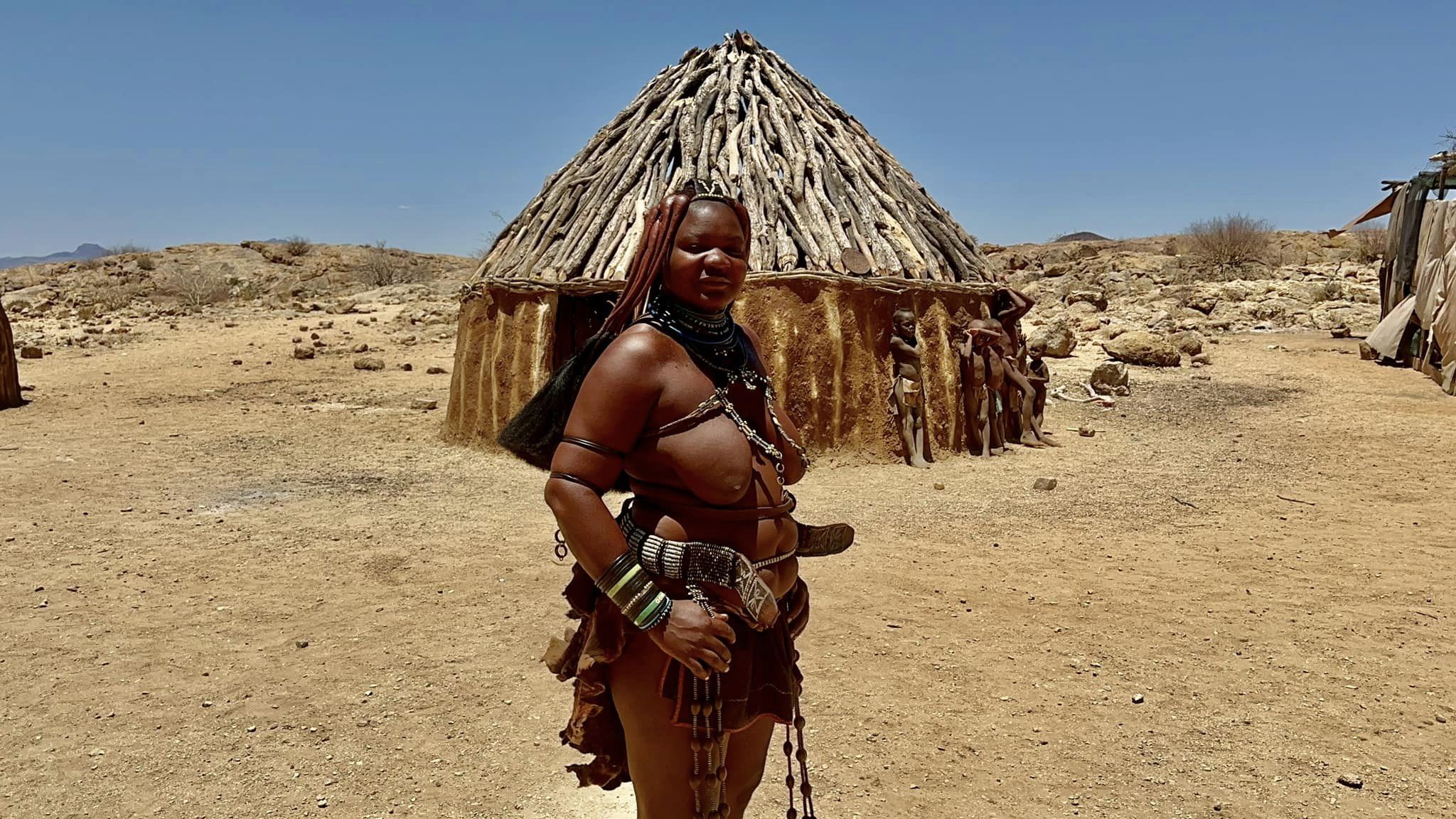
They willingly took pictures with us, saying something in their strange clicking language and laughing.
Numerous children were running around the dusty ground either completely naked or wearing short loincloths.
They were actually such cool guys and girls!
And then they were dancing, being accompanied by the women's clapping their hands and singing loud melodies. The men participated as well.
I tried to dance with them but, frankly speaking, it turned out not that fine. I had no experience and necessary skills.
The Bushmen is one of the oldest folks on the planet Earth. They formed the tribes 50...100 thousand years ago and still exist nowadays. Scientists have proved that this is not a joke. They made such a conclusion after doing the research of Y-chromosome..
The Egyptians, Greeks and Chinese are children in comparison with them. However, the Bushmen did not create empires and actually never had their own state. They have lived all these 100 or maybe 200 thousand years in tribes, making their living by hunting, collecting herbs and other gifts of nature, without thinking much about technical progress.

We came to the Bushmen's village early in the morning. They did not invite us to their houses constructed of twigs and straw, but then immediately built a new one in an hour and a half. The house for three people turned out to be quite small, with a total square of about 4 m².
The Bushmen differ from the Himba in the same way as the Russian differ from the Chinese.
They have completely different genotypes, although they live in the same area. The language of the Bushmen is not similar to any other African, let alone European and Asian languages. It has such clicking sounds that do not exist in our phonetics at all. The bushmen are quite short, thin, dry and their skin is not as black as the one of the most African peoples. They are smiling, sociable and cheerful.
Like all the inhabitants of Africa, they love to sing and dance. The only musical instruments I saw that they have were wooden mallets and their own palms.
The Bushmen are excellent hunters. With the help of a bow and an arrow, they can get an antelope or even a giraffe. If one was lucky and managed to kill a big animal, its meat would be hung on the trees to be dried.
There are a lot of children. They run naked and barefoot all around, without seeing the thorns on the road and being all covered in dust, but they are well-fed and healthy.

It is said that if a child was born frail or sick, then he or she would not be nursed... And the mother herself would admit that it didn't work out.
Therefore, only the healthy survive. And that's it.
They extract medicines from plants.
The Bushmen do not have passports and live on their own, separate from any state institutions. They do not watch TV, do not scroll the Internet.
What happy people they are!
comments powered by HyperComments Cap-travel.ru
Cap-travel.ru